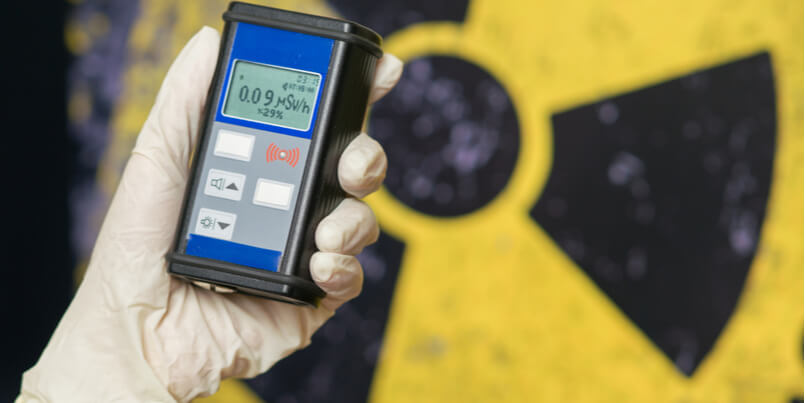 The monitoring of gamma radiation is crucial for preserving human life and maintaining environmental safety, whether it is in the context of military peacekeeping activities, border control, law enforcement, first response or as part of routine surveillance within medical or industrial facilities.
The monitoring of gamma radiation is crucial for preserving human life and maintaining environmental safety, whether it is in the context of military peacekeeping activities, border control, law enforcement, first response or as part of routine surveillance within medical or industrial facilities.
Gamma rays pose a particular threat because of the highly energetic nature of their electromagnetic waves which operate at a frequency of 10 to the power of 20 (or 10 quadrillion) waves per second.
Gamma radiation has the power to penetrate virtually anything - passing easily through human bones and teeth, destroying human cells, producing mutations in DNA and causing cancer.
Despite their inherent dangers however, gamma rays also have a significant lifesaving role to play in clinical medicine, being used most commonly in the fields of radiotherapy and radio-oncology to shrink tumours and kill cancer cells.
The science behind gamma ray detection
Just like visible light, gamma rays are comprised of packets of energy known as photons. In the case of gamma however, their photons are millions of times more energetic than visible light.
Gamma rays can be detected by observing how they interact with matter. When they collide with an electron they can bounce off it - or they can push it to a higher energy level causing photoelectric ionization.
In the process of these interactions an electric current is created - which can in turn be amplified and measured in order to determine the energy and the direction of the original gamma ray.
The role of radiation survey meters
Portable, battery-powered, electronic survey meters can be used wherever gamma radiation is suspected to be present, both to detect the activity and to measure the dose rate from the radioactive material.
Survey meters that are equipped with gamma sensitive probes (whether internal or external) are essential tools in locating sources of radiation, establishing control zone boundaries, ensuring safe demarcation and controlling personal exposure.
Although there are variations in design, a survey meter is typically comprised of three components:
- A sensor (in a probe or within the meter) which converts the ionizing radiation into an electric signal
- An electronic scaler that converts the electrical signal into a visual/numerical indication of intensity
- A speaker which provides an audible indication of the ionizing radiation count or dose rate
Some survey meters are constructed as fully integrated units (with the probe and electronic processor encased in the one housing) while others may be designed for use in conjunction with one or more external detector probes.
There are also detectors, for example the FH 40 G Multi-Purpose Digital Survey Meter, that are able to fulfill multiple radiation applications within the one instrument.
What are the key attributes of an effective survey meter?
A System Assessment and Validation for Emergency Responders (SAVER) study conducted by the US Department of Homeland Security provides some interesting insights into the criteria that first responders consider important in an effective survey meter.
The study enlisted the expertise of six highly experienced responders working across a range of emergency response disciplines including HazMat, search and rescue, medicine, radiological protection, the fire service and law enforcement.
The features which they highlighted as being most important in a survey meter were:
Capability - the power, capacity and features of the equipment, including radiological performance, data storage, standards conformance and safety features.
Deployability - including the durability of the unit or system, the method of battery replacement, the weight of the item and how easily the device can be stored, transported and implemented.
Maintainability - focused on the required servicing and calibration of the equipment to ensure operational condition.
Usability - rating the quality of the responder's experience when deploying the equipment, including factors such as the presence of a clear display interface and alarms/audible options.
Affordability - considering both the up-front and life-cycle costs of the equipment.
How simulators can enhance radiation safety training
The integration of electronic radiation simulators into training exercises can have a crucial role to play in preparing CBRNe and HazMat personnel for the realities and the challenges of live incidents involving gamma radiation.
A well-designed simulator detector should authentically replicate the appearance, the weight and the functionality of the actual device.
It should help the operator to understand the relationship between the measurements on their survey meter and their own personal dose readings.
It should enable trainees to experience the real-time effects of Time, Distance and Shielding.
And it should offer the reassurance of delivering consistent readings so the trainees can have complete faith in the values displayed on their equipment.
Simulator detectors provide the opportunity for trainees to experience the characteristics and the behaviour of gamma radiation in a safe and immersive learning environment - and in a literally unlimited variety of training scenarios.
If you would like to learn more about how simulator technology can aid your CBRNe training then please download our free eBook below.







